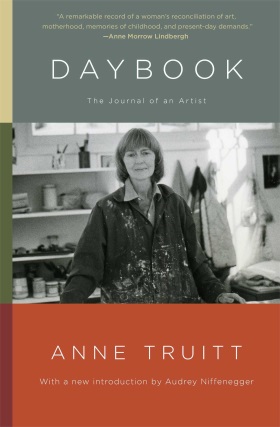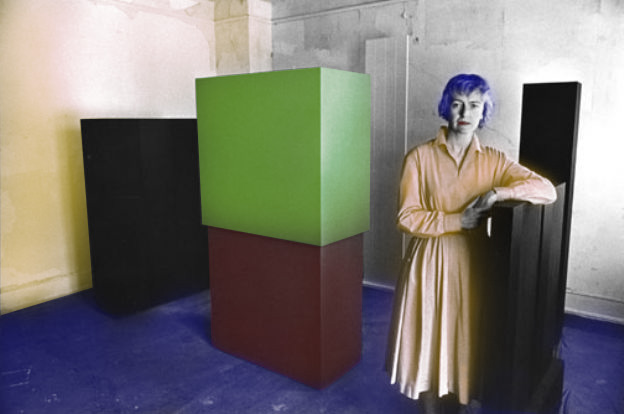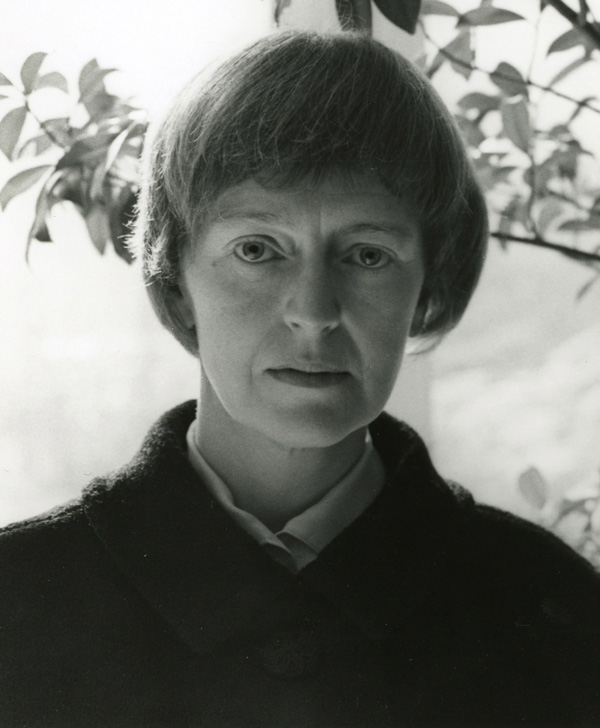New Media : Artist Book -> old media of writing (ie Diary : Anne Truitt) & New Media of the electronic portfolio + data display (statistic prof: Hans Rosling)
http://www.brainpickings.org/index.php/2014/08/27/anne-truitt-daybook-artist/
Anne Truitt on Resisting the Label “Artist” and the Difference Between Doing Art and Being an Artist
by Maria Popova
“Artists have no choice but to express their lives.”
 At the age of fifty-three, the influential artistAnne Truitt (March 16, 1921–December 23, 2004) confronted the existential discomfort any creative person feels in facing a major retrospective of his or her work — the Corcoran Gallery of Art had just staged one of Truitt’s. A retrospective, she felt, forces upon the artist a finite definition — this is what your work is, this who you are. It attempts to make visible and static those invisible, ever-fluid forces that compel an artist to make art.
At the age of fifty-three, the influential artistAnne Truitt (March 16, 1921–December 23, 2004) confronted the existential discomfort any creative person feels in facing a major retrospective of his or her work — the Corcoran Gallery of Art had just staged one of Truitt’s. A retrospective, she felt, forces upon the artist a finite definition — this is what your work is, this who you are. It attempts to make visible and static those invisible, ever-fluid forces that compel an artist to make art.
To tease out her unease, Truitt set out to explore the dimensions of her personality and her creative impulse in a diary, in which she wrote diligently for a period of seven years. It was eventually published asDaybook: The Journal of an Artist (public library) — an extraordinary, soul-stretching collection of meditations on the trials, triumphs, and self-transcendence of the creative life.
Truitt once described her art as concerned “with the limen of consciousness, with the threshold at which experience becomes just perceptible,” but it is in the privacy of the diary that she ventures past that threshold and into the furthest frontiers of the psyche — her psyche, the artist’s psyche, the universal human psyche. Trained as a psychologist and with only one year of formal education in art, Truitt made a decision to “ride out the jeopardy of art with as much courage and faith” as possible. From this unusual standpoint, she reaches depths of insight and self-awareness inaccessible to most artists — to most human beings — and pulls out of them luminous wisdom on the love, labor, and life of art.
In one particularly poignant series of journal entries from the summer of 1974, Truitt exorcises the chronic resistance many artists have to the label of “artist” and the perils of letting others define you. On July 2 that year, she writes:
I do not understand why I seem able to make what people call art. For many long years I struggled to learn how to do it, and I don’t even know why I struggled. Then, in 1961, at the age of forty, it became clear to me that I was doing work I respected within my own strictest standards. Furthermore, I found this work respected by those whose understanding of art I valued. My first, instinctive reaction to this new situation was, if I’m an artist, being an artist isn’t so fancy because it’s just me. But now, thirteen years later, there seems to be more to it than that. It isn’t “just me.” A simplistic attitude toward the course of my life no longer serves.The “just me” reaction was, I think, an instinctive disavowal of the social role of the artist. A life-saving disavowal. I refused, and still refuse, the inflated definition of artists as special people with special prerogatives and special excuses. If artists embrace this view of themselves, they necessarily have to attend to its perpetuation. They have to live it out. Their time and energy are consumed for social purposes. Artists then make decisions in terms of a role defined by others, falling into their power and serving to illustrate their theories. The Renaissance focused this social attention on the artist’s individuality, and the focus persists today in a curious form that on the one hand inflates artists’ egoistic concept of themselves and on the other places them at the mercy of the social forces on which they become dependent. Artists can suffer terribly in this dilemma. It is taxing to think out and then maintain a view of one’s self that is realistic.
This dilemma, Truitt cautions, is compounded by the contradictions ofcommercial art and the conflicting forces of authenticity and pragmatism that often force upon artists the choice between creative authenticity and commercial success:
The pressure to earn a living confronts a fickle public taste. Artists have to please whim to live on their art. They stand in fearful danger of looking to this taste to define their working decisions. Sometime during the course of their development, they have to forge a character subtle enough to nourish and protect and foster the growth of the part of themselves that makes art, and at the same time practical enough to deal with the world pragmatically. They have to maintain a position between care of themselves and care of their work in the world, just as they have to sustain the delicate tension between intuition and sensory information.This leads to the uncomfortable conclusion that artists are, in this sense, special because they are intrinsically involved in a difficult balance not so blatantly precarious in other professions. The lawyer and the doctor practice their callings. The plumber and the carpenter know what they will be called upon to do. They do not have to spin their work out of themselves, discover its laws, and then present themselves turned inside out to the public gaze.
But Truitt soon sees another angle of this living-out of the artist — living out not one’s role of being an “artist,” a performance of sorts, but living out one’s immutable experience of doing art:
The terms of the experience and the terms of the work itself are totally different. But if the work is successful — I cannot ever know whether it is or not — the experience becomes the work and, through the work, is accessible to others with its original force.For me, this process is mysterious. It’s like not knowing where you’re going but knowing how to get there.
A few days later, in an entry reflecting on the work of the celebrated sculptor David Smith and, by extension, on all great art, Truitt writes:
He seemed never to forget that he was an artist. He just plain chose not to.[...]Artists have no choice but to express their lives. They have only, and that not always, a choice of process. This process does not change the essential content of their work in art, which can only be their life.
A month after her original resistant contemplation of the label “artist,” Truitt revisits the subject, exercising the uncomfortable luxury of changing one’s mind with an acknowledgment that in order to unblock the “spiritual electricity” of creative flow, one must begin with a submission to the role of artist. On August 6, she writes:
In skirting the role of the artist, I now begin to think that I have made too wide a curve, that I have deprived myself of a certain strength. Indeed, I am not sure that I can grow as an artist until I can bring myself to accept that I am one.Part of my intense discomfort this past year has been that I was pried out of my place there. I was attached to my secret burrow, which now begins to feel a little stale.And also egotistic, confined, even imprisoning. I begin to see that by clinging to this position I was limiting what I had to handle in the world to what I could rationalize. As long as I stayed within my own definition of myself, I could control what I admitted into that definition. By insisting that I was “just me,” I held myself aloof. Let others claim to be artists, I said to myself, holding my life separate and unique, beyond all definition but my own.[...]The open being: I am an artist. Even to write it makes me feel deeply uneasy. I am, I feel, not good enough to be an artist. And this leads me to wonder whether my distaste for the inflated social definition of the artist is not an inverse reflection of secret pride. Have I haughtily rejected the inflation on the outside while entertaining it on the inside? In my passion for learning how to make true for others what I felt to be true for myself (and I cannot remember, except very, very early on, ever not having had this passion), I think I may have fallen into idolatry of those who were able to communicate this way. Artists.So to think myself an artist was self-idolatry. In a clear wind of the company of artists this summer, I am gently disarmed. We are artists because we are ourselves.
Daybook is a spectacular read in its entirety, with wisdom on everything from the role of daily routine and environment to the relationship between mental health and creativity. Complement it with Dani Shapiro on the pleasures and perils of the creative life and Anna Deavere Smith’s superb Letters to a Young Artist.


No comments:
Post a Comment
Note: Only a member of this blog may post a comment.